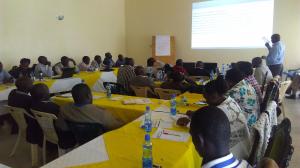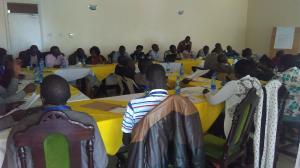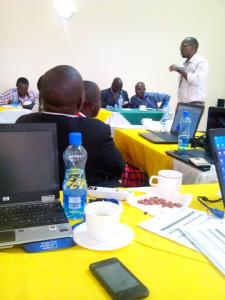Baringo County Capacity building workshop on integrated-food-security programming and Disaster Risk Reduction Strategies - Auslandsbüro Kenia
Workshop
Details
The tailored capacity training was held on the 21st of August to 26th of August 2016 at Kabarnet Hotel and replicated the same strategy pursued in West Pokot (although with minor modifications). An average of 49 participants were engaged in the training with the number of women being an average 10, while that of men being an average 39. The participants included, 6 Sub-County administrators (from Baringo North, South, Central, Tiaty, Mogotio and Eldama Ravine), 2 town administrators (Eldama Ravine and Kabarnet) ward administrators from the 30 wards, key public officials from the County Departments of Agriculture, livestock, civic education, food security and Disaster Management. Also represented in the training were the NDMA, Provincial Administration, and other key stakeholders like the Agricultural Sector Development Support Programme (ASDSP). The training was more-less conducted like that of West Pokot, with three trainers who had extensive knowledge in the areas of public policy process, disaster risk management and food security. The County Drought Information officer from NDMA was also engaged and specifically made presentations on matters drought management, disaster risk management and the mechanics of the Community Managed Disaster Risk Reduction (CMDRR).
The first three days focused on simple lectures, power-point and e-case presentations on the concepts of disaster management, drought and famine early warning, and food and nutrition security. The main sessions were tailored to ensure maximum participation from the participants so as to afford them ample time and space to relate the policy concepts to practice in their wards. Findings from the KAS food security mapping and analysis report was also used to advance further the issues under discussion(s). On the third day, a presentation on the Draft Baringo Disaster Management Policy was made by officers from the County Disaster Management Unit. Unlike West Pokot where presently, there is a Disaster Management Act, in Baringo, the focus was largely on validating an existing draft policy framework. The presentation of the draft county policy framework was compared to the Draft National Policy for Disaster Management in Kenya for purposes of streamlining vertical coordination, linkages and resources. Being the main coordination, supervision and management structure for administrative functions on behalf of the County Government as per the County Government Act of 2012, Ward administrators and Sub County administrators were therefore the focal point for policy implementation in respect to ensuring successful community service provision; including, eventually, implementing properly the policy intentions meant to reduce emergencies and reliefs during disaster occurrences. Among the issues discussed by participants in the first three days, as a direct consequence of the training included: the weaknesses of the current disaster management architecture, recent initiatives conducted based on early warning information, overall county challenges to implementing food and nutrition security of which comprised crises such as insecurity in Mukutani, Kapedo and Muchongoi, land and boundary contestations, poor investment in infrastructure (roads and facilities such as public schools) and generally, the lack of a programme framework with clear-transparent budgetary process that is premised to promote, sustain and retain in the long run, local solutions to crises that are of disasters and food security in nature.
The other two days of the training entailed re-looking back at the national level food and nutrition security policy architecture and later on, group works and plenary deliberations followed on practical approaches that Baringo County Government could use to customize and ensure that the eventual policy framework had strong linkages and feed-back mechanism in regard to other existing sectoral and mainstream policy frameworks like the County Fiscal Strategy Paper, County Integrated Development Plan, the county approved budget, annual development plan. To ensure that the policy formulation process started in the right footing, the Ward administrators came up with an ad hoc committee made up of representation from the 6 Sub Counties, purposely to spearhead a collective plan that will guide community participation in the process of problem identification as well as agenda setting at the location and ward levels. The two phases are the most critical in the development/customization of the county level food and nutrition security policy. With the knowledge gained, the participants deemed the development of the county level policy important due to the fact that in the County Fiscal Strategy Paper, 2016/17 (a framework that aims at accelerating the economic growth prospects, employment and livelihood in the county) and in effort to ensure attainment of food security and sustainable land management, 519.8 million Kenya shillings have been allocated for a number of programmes including livestock upgrading, treatment, purchase of hydro form and land banks among others. Without a policy framework, sustainable distribution of the resources would be a difficult task to attain. To this end, KAS will be working closely with the County Government of Baringo and other stakeholders to monitor and where fitting, to assist in the process of the policy development.
Last but not least, participants were taken through the Community Managed Disaster Risk Reduction (CMDRR) and the existing strategies and plans. The incorporation of the CMDRR plans into the annual development plans, both at the ward and county levels plans was noted as important. With exception of wards where World Vision Kenya and NDMA had initially supported the development of the CMDRR, the participants picked on 6 more wards for group exercise; one from each Sub County. Mukutani, Koibatek, Emining, Muchongoi, Saimo Soi and Silale wards were identified for the development of the model CMDRR plans. The framework and guidance was provided by NDMA. Upon the presentation of these plans, it was unanimously agreed that it will be necessary for the County Draft Disaster Risk Management Policy to integrate the aspect of CMDRR strategies and plan matrix as this will ensure more informed resource allocation, sustainability and community participation. KAS together with NDMA, World Vision Kenya and I serve Kenya will work closely to help validate the 6 CMDRR plans in citizen forums at the ward level, as well as later on playing part (where necessary) to assist the remaining counties develop each a CMDRR plan. Nevertheless, one recommendation to the County Government in line with the views of the participants is that the process of wide-spreading the concept of CMDRR will be sounder if and when there is a clear inclusion of the CMDRR plan into the policy draft before it’s finalized.







